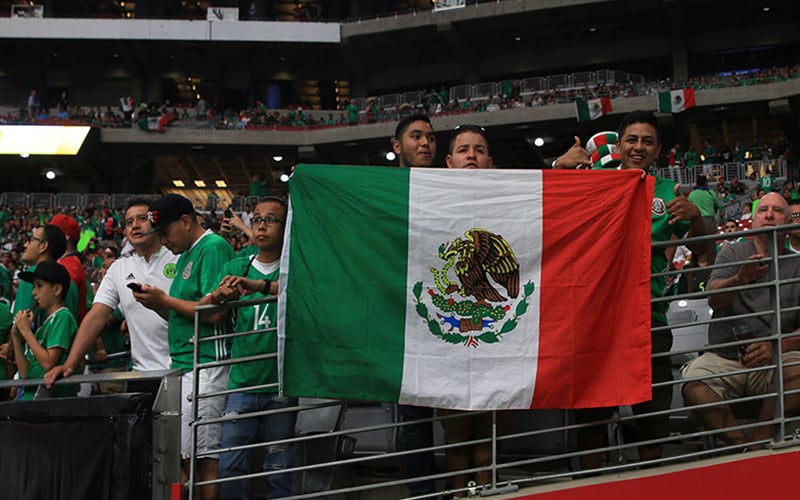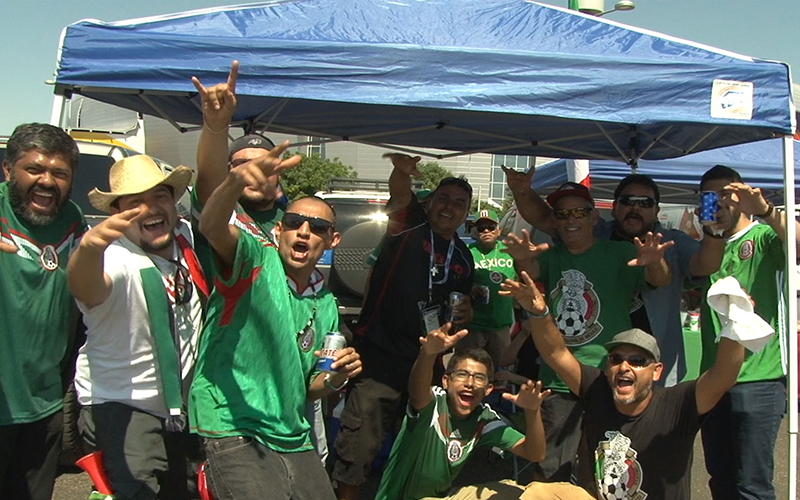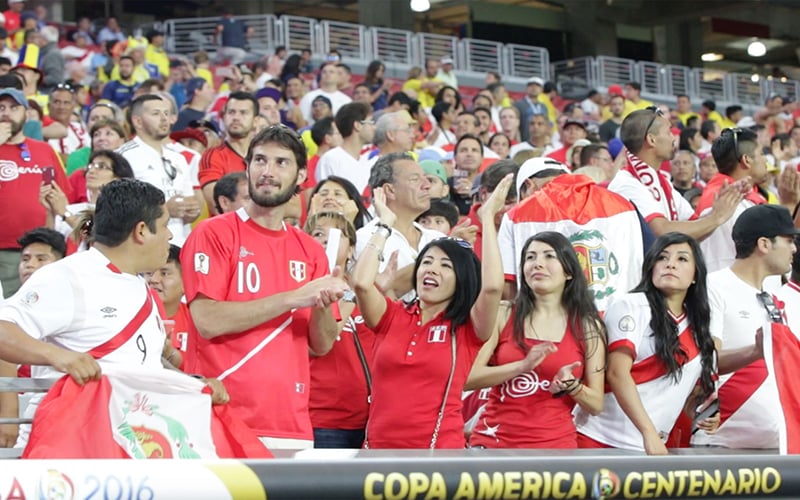
Supporters of the Mexican National Soccer Team pose with the Mexican flag just before the start of the game. (Photo by Joe Steen/Cronkite News)
GLENDALE — Thirteen-year old Braulio Estaco had never attended a soccer game, let alone a game as big as a Copa America match, before he arrived at the June 5 Group C contest between Mexico and Uruguay at University of Phoenix Stadium.
“I traveled here all the way from El Paso, Texas, with the family,” Estaco said. “I don’t know what to expect, but I’m very excited for it.”
University of Phoenix Stadium hosted two Copa America games earlier this month, with one more coming on June 25. Arizona United owner Kyle Eng believes the passion surrounding these matches will help contribute to soccer’s growth in the Valley and could lead to a Major League Soccer franchise here in the future.
Arizona United SC plays in the United Soccer League, the third division of soccer in the United States, two tiers below MLS. Eng said Arizona United’s ultimate goal is to become an MLS team, but he understands that could take a while in a market that already has four major professional sports teams – the Cardinals, Diamondbacks, Suns and Coyotes – along with the Mercury and Rattlers.
“Winners aren’t built overnight,” Eng said. “We’re up against some iconic brands in this town who’ve had a 20-year head start. We have to go about growing it differently.”
Eng said the atmosphere surrounding soccer sets it apart from the other sports.

Fans of the Mexican National Soccer Team tailgate before Mexico’s Copa America match against Uruguay at University of Phoenix Stadium. (Photo by Joe Steen/Cronkite News)
“Where else are you going to find 90 minutes of non-stop action?” Eng asked. “The fans keep you involved throughout the whole game, as well as the game itself.”
Eng said the Mexico-Uruguay match, and the nearly 60,000 soccer fans it drew to Glendale, helped bring more exposure to soccer in the state.
“When you have that kind of an attendance at a big game, it’s encouraging for soccer here in Arizona,” Eng said.
Professional soccer has traveled a meandering road in the Valley since the birth of the Arizona Sahuaros in 1989. That team made its debut in the Premier Development League in 1990, playing at the soccer stadium on what is now the campus of Grand Canyon University. The team played for nearly 20 years, but bounced between leagues. In 2009, the Sahuaros left professional soccer and now compete as an amateur team in the United States Adult Soccer Association.
Phoenix FC was born three years later and played its first and only season in the USL in 2013. In November of that year, the league stripped the original owners, BDR Sports, LLC, of their franchise rights for violations of the franchise agreement. One month later, the rights were given to American Soccer Marketing, LLC, but in March 2014 it announced it could not continue operating the team. Eng launched Arizona United the next day.
Soccer fan Rafael Marcedo, who attended the Mexico-Uruguay game in Glendale, said that he enjoys having a team like the United in the Valley, but he would love to see an MLS team here down the line.
“I have been to the last two games for Arizona United and it’s a great time to take the kids and go watch a game,” said Marcedo, who grew up in Puerto Vallarta, Mexico, playing soccer and supporting Chivas Guadalajara. ” But I hope in the future that Arizona will have an MLS team because we love soccer. I hope this is the beginning toward having that Division I team here.”

Peru fans look on before the start of their team’s Copa America match against Ecuador. (Photo by Joseph Steen/Cronkite News)
Eng believes another step in the process is the cultivation of the sport among young athletes in Arizona.
“Soccer is the fastest-growing sport among youths,” Eng said. “Along with Hispanics, we are trying to get them involved as much as possible. (The United) have the team and a great coach. Hopefully everything comes together.”
According to U.S. Youth Soccer, participation in the sport among 12- to 17-year-olds was 30 times higher in 2014 than it was 40 years earlier. The Wall Street Journal reported in that same year that youth participation in soccer is double that of tackle football and has 1 million more participants than baseball.
The nationwide jump in youth soccer hasn’t gone unnoticed by the MLS. The league has rolled out an aggressive expansion plan that would wind up adding six teams over a six-year period, but there has not yet been any significant mention by the league of Phoenix being among of them.
Orlando City SC and New York City FC began play last year. Both teams experienced instant success at the gate, finishing second and third in attendance in their respective inaugural seasons.
Atlanta will join the league in 2017. That team will be owned by Atlanta Falcons owner Arthur Blank and will play in the Falcons’ new home, Mercedes-Benz Stadium. Los Angeles and Minnesota have also been awarded teams by the league and both are expected to begin play in 2018.
The new Los Angeles team will replace Chivas USA, which disbanded after the 2014 season, and join the Galaxy as the second MLS team in southern California. MLS plans to add a 24th team by 2020 and has looked at Sacramento, St. Louis, Detroit, San Antonio and Austin. The league has said its ultimate goal is to get to 28 teams in the future.